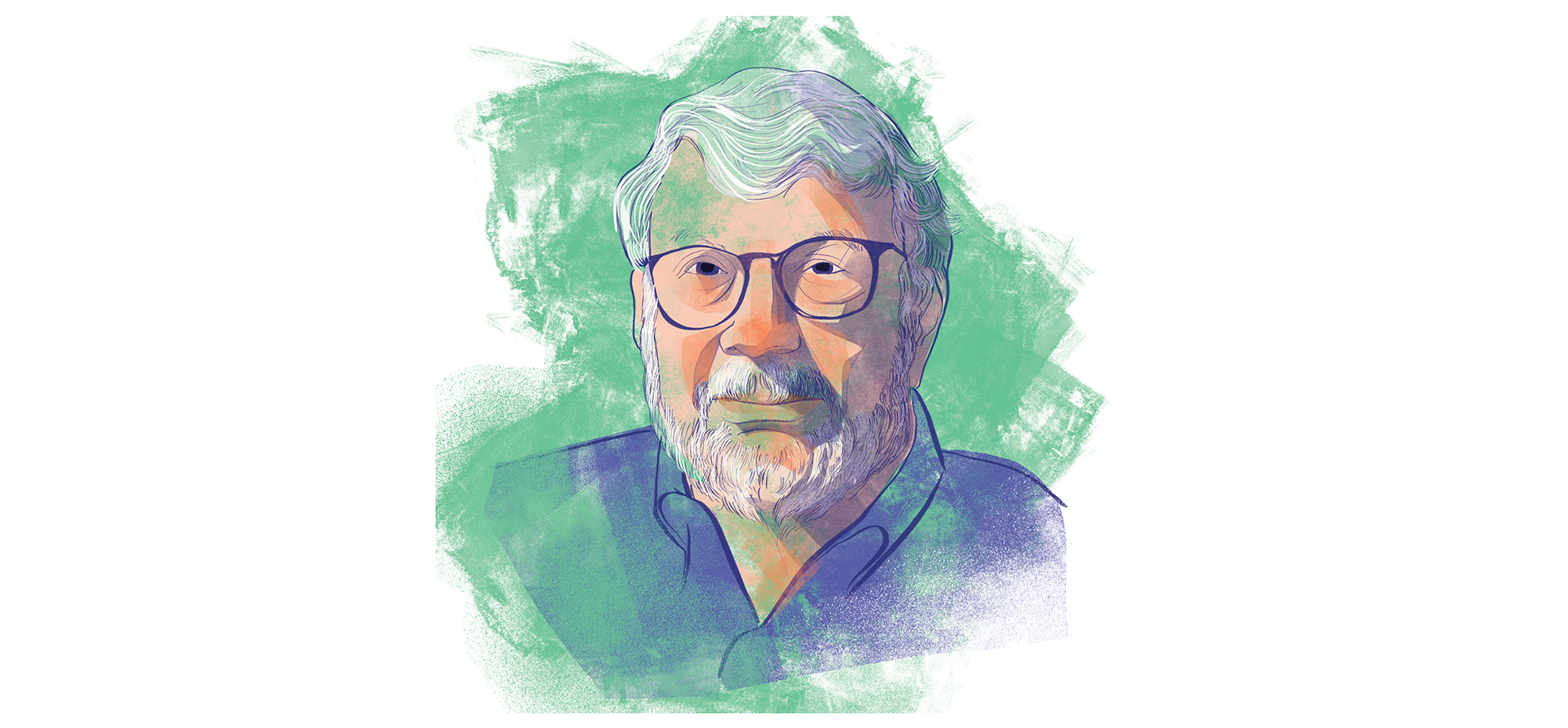
(Illustration by John Jay Cabuay)
Peter Dreier, AM’73, PhD’77, examines how social movements changed baseball history.
Like a baseball scout, Peter Dreier, AM’73, PhD’77, takes special note of lefties—but not pitchers and hitters. He focuses on the political variety. They’re the stars of his two recent books, Baseball Rebels: The Players, People, and Social Movements That Shook Up the Game and Changed America (University of Nebraska Press, 2022) and Major League Rebels: Baseball Battles over Workers’ Rights and American Empire (Rowman & Littlefield, 2022). An Occidental College professor of politics and urban and environmental policy, Dreier cowrote the books with University of San Francisco professor and political scholar Rob Elias. This interview has been edited and condensed.
How did you end up publishing two books at the same time on similar themes?
We had this outline of who we were going to write about and it sort of got out of hand, to be honest with you. At the end of the day we had a 600-page book. The publisher said, “We’d have to charge like 60 bucks and it wouldn’t sell, so cut it in half.” That was like cutting my heart out. So we had to find another publisher and we divided the books into different topics.
Labor movements in pro baseball date back to the 19th century, but players didn’t form a union until the 1950s. Why did it take so long?
I think it has to do with the fact that a lot of ballplayers were just glad to be getting paid to play baseball. Otherwise they’d be working on a farm, they’d be sharecroppers, or they’d be working in a factory or at a textile mill or something like that. Baseball players didn’t get paid very much, but they got paid more than mill workers.
What factors led them to organize, and what resistance did they face?
Team owners were like baseball’s robber barons. They’d cut your pay, they’d charge you for your uniform, they’d charge you to clean your uniform. The working conditions and the pay were pretty bad, but the idea of a union was sort of foreign. The reason it’s called the “players’ association” is because there was a lot of trepidation about being part of a union.
Who were the leading voices on labor issues when the players’ association began?
The union leadership in the ’50s and ’60s were stars of the era like Allie Reynolds, Bob Feller, and Bob Friend. None of them were lefties, but they felt that baseball is a craft and these people are the best at what they do. They didn’t want to be treated like unskilled workers, even though some of them identified with the broader labor movement. It was like the early days of the American Federation of Labor where the first union efforts were among craft workers who thought their skills were being either de-skilled by factory work or taken for granted.
When speaking out for economic or social causes in baseball, the messenger seems to matter a lot.
It was important that the leaders of the union were mainstream top players. In fact, I quoted veteran major league player and manager Bobby Valentine in Baseball Rebels about gay players, and he said, “It’d be a lot easier if the first gay player to come out was an all-star.”
The start of the 1968 season was delayed after Martin Luther King Jr.’s assassination—at the behest of players, not owners or the league itself.
Historical accounts say baseball, like all the other sports in America, decided to honor his memory by shutting down for two days. But that’s not what came down. William Eckert, the former general who was the commissioner of baseball at the time, said it’s up to each team. Pittsburgh Pirates infielder Maury Wills started it. And then Pirates outfielder Roberto Clemente—once he got on board, he got all the other players. And it turns out that St. Louis first baseman Orlando Cepeda and pitcher Bob Gibson had the idea for the Cardinals. They didn’t go to the union, so it was essentially a two-day wildcat strike. And I’ve never seen any story that acknowledged that’s what it was, a wildcat strike over racism.
Who are today’s heirs to these traditions?
The heroes now are people like Washington Nationals pitcher Sean Doolittle, who is the Mother Jones of Major League Baseball. He’s just a remarkable person. It helps that he’s a great pitcher. When he came into the majors and started speaking out on gay rights and on racism, he was an all-star. Also, his parents were in the military. He and his wife did a lot for military veterans, so even though he’s a socialist, it’s hard to pigeonhole him. Another one is San Francisco Giants manager Gabe Kapler. He was the first manager to take a knee and said the most American thing we can do is peacefully protest. Los Angeles Dodgers outfielder Mookie Betts, same thing. He led the Dodgers in deciding not to play following the shooting of Jacob Blake.
What was the impact of the lockout that delayed the start of the 2022 season?
The way most of the media framed this was “millionaire players versus billionaire owners.” I think 25 percent of all players last a year in the majors, and the median is three or four years. And during those four years they go up and down between the majors and minors, so they don’t even get the minimum, about $550,000. That’s a lot of money, but not if your career is three or four years long. During the lockout, pitcher Walker Buehler, the Dodgers’ player rep for the union and not an outspoken political person, tweeted, “This isn’t millionaires vs. billionaires. This is workers vs. owners.” [Buehler later deleted the tweet.—Ed.] I don’t know what’s going to happen in the future, but a lot of players were really radicalized by the lockout.
